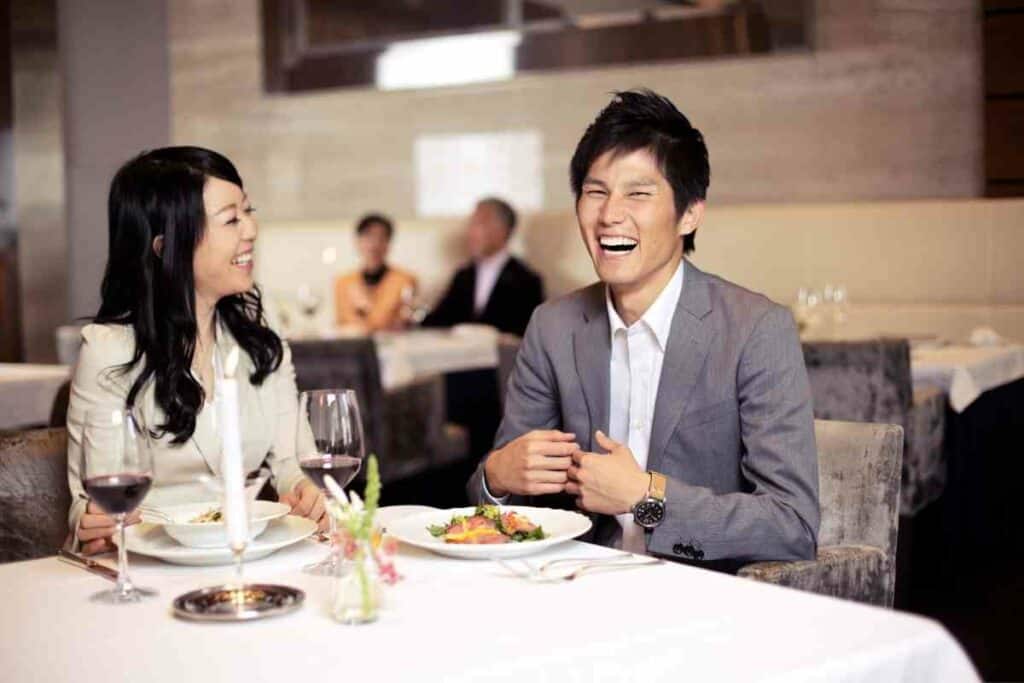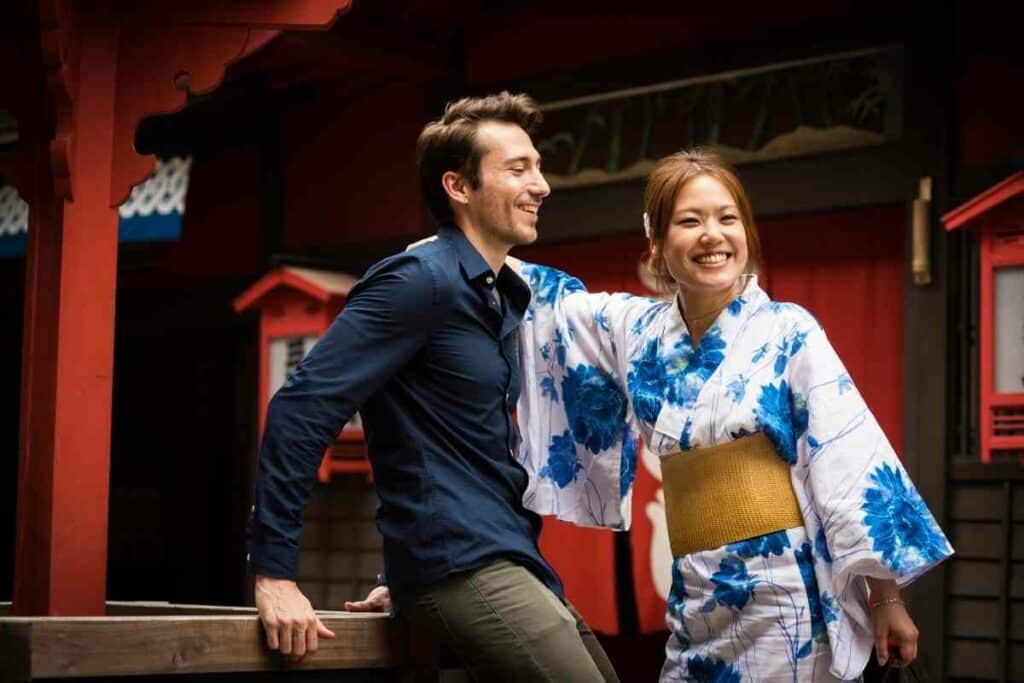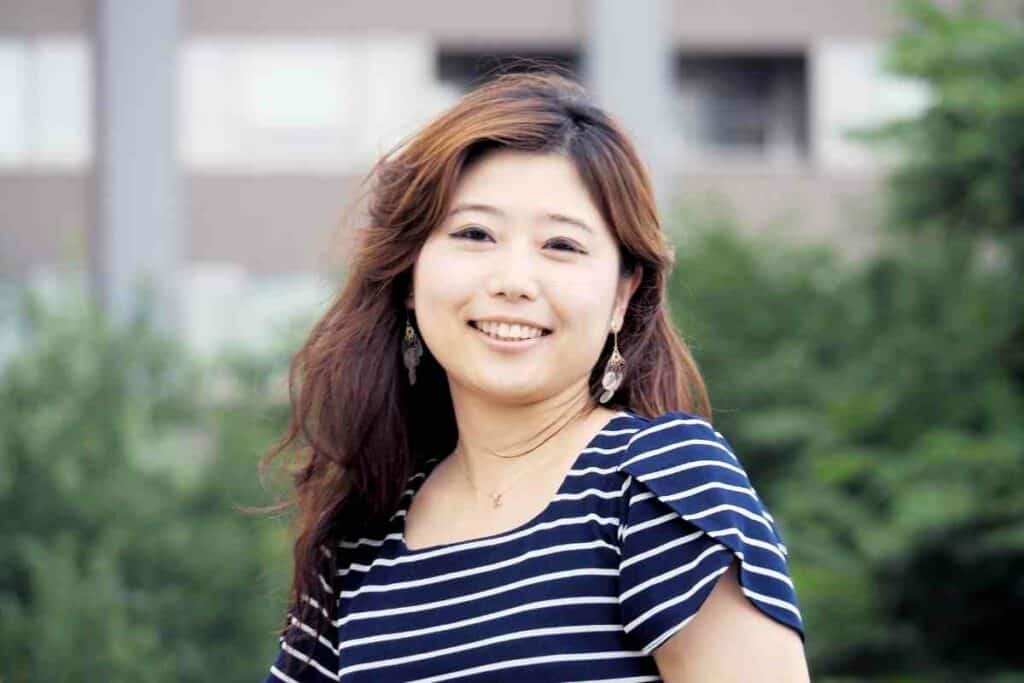The Western world often has different ideas on dating and marrying compared to Japanese people.
Of course, there are also lots of similarities. In Japan, marriage has a longstanding history and is based heavily on gender roles from Confucian ideals.
Before we go into modern Japanese wife culture and dating culture, it’s important to know that love is embroiled in Japanese culture and tradition.

One such example is the Tanabata festival. During this festival (also called the Star Festival), Japanese women pray for good fortune in love or good relationships.
This festival celebrates the meeting of Hikoboshi and Orihime, two deities. The stars Altair and Vega represent these deities.
Gear up for your Japan journey! Discover essential travel items and immerse in Japan’s culture with our partner, Japan Objects Store.
Legend has it that these lovers are separated by the Milky Way and it’s only on the 7th day of the 7th month that they’re allowed to meet each year.
In This Article – We’ll look at Japanese dating culture and wife culture to give you the lowdown on everything you need to know if you’re looking for love in this country.
Table of Contents
Dating Culture in Japan
The idea behind dating is generally to get to know someone better.
All different cultures have their own unwritten rules on courtship and dating but there are usually some common themes and ideas that are shared across all cultures.
Typically, these include:
- Expressing an interest in a person and wanting to know more about them
- Listening to each other
- Not rushing things
In Japan, these ideas are true too.

There are some big differences though in Japanese wife culture and dating, and one big difference is when physical intimacy comes into a relationship.
In Japan, a relationship will typically take longer to cross over into physical intimacy.
Of course, exceptions exist but usually, couples won’t even hold hands or kiss until after kokuhaku (we’ll discuss what this is further into the article).
Keep In Mind – When you are in a relationship in Japan, it’s also taboo to be intimate in public.
While in Western areas, it’s often normal to hold hands, embrace, and kiss in public, it’s not typically a done thing in Japan. This is down to the concept of uchi-soto.
The Concept of Uchi-soto
If you’re learning Japanese, you might already have some knowledge of Uchi-soto.
Essentially, uchi means insideand soto means outside. This concept means that Japanese people will behave differently at home and in public.
There is a lot of pressure to be considerate and respectful to others.
Japanese men tend to conform and fit into their role because of the cultural expectations they’re brought up with.

It might mean that they act in a certain way in public, but it isn’t who they are at all.
This might mean that you could end up really liking someone but as you get closer and learn more about them, you can find that they’re someone else entirely.
More and more Japanese women are preferring the Westerner attitude of being open, but culture shift takes a long time to happen.
Booking.comAmae
Due to uchi-soto lots of Japanese people are not transparent with their feelings.
This behavior is called amae. It involves trying to read one another’s feelings.
Men in Japan are, therefore, more indirect and subtle when they approach women due to the norms in Japanese society.
They’re encouraged to be tactful, highly considerate, and subtle. They might not even approach women at all because of this.
Friendship First
Before any dating begins in Japan, there is something called gokon.
Essentially, this is a group blind date. It’s important in Japan that friends approve of the person you’re dating.

When there has been around five or six gokon, people will usually go off in pairs to the movies, for a coffee, or on other activities that are typical dates.
Generally, though, these happen in public, and the couple isn’t considered to be dating yet.
The next step – kokuhaku
We mentioned kokuhaku briefly before.
This is the actual phrase where dating begins. However, it isn’t like Western dating and many Westerners will see this practice as strange.
Kokuhaku means “confession” and it is the culture of confessing one’s love. You might have seen this in animé.

It’s an exciting time in a Japanese person’s life. When someone likes somebody, they will confess this and ask whether they can be lovers.
Once this process has happened, you are in an exclusive, committed relationship.
Waiting for acceptance or approval is somewhat daunting but afterward, you’re officially in a committed relationship.
There are unwritten rules about kokuhaku. For example, you should never do it via text message, but you could do it inside a New Year’s card.
In the West: The phrase I love you is strong and is usually only said after you’ve been in a relationship for a while. In Japan, however, this is how the relationship starts.
Japanese Wife Culture – Marriage
Just like in other countries, rituals for marriage vary among families.
Historically, like many countries, Japan used to practice arranged marriages. The idea with marriage was to continue family lines.
Women would be brought up to be wives and mothers, even sacrificing their own happiness to do so.

Times have changed, though, and many women now work, and men do their share of the housework.
In the West – It has been common to expect women to be virgins upon marriage. Virginity was associated with purity and chastity.
These ideas weren’t brought to Japan until the 1800s. This doesn’t mean that it was deemed acceptable for women to engage in sex.
There was still a view that women were the property of their fathers or husbands and if adulterous, women would be penalized (unlike men).
The influence of Confucian ideals
Confucian society was focused on family with men being heads of the house and women being dependent on them.
Even though folklore depicted love within marriage to be the ideal, traditional marriages were simply business contracts between two families.
In this “business contract,” husbands could return their wives to their family if there was no heir produced or if she caused disruption.
Marriage was simply about lineage, and it was common to have three generations in one house.
Modern Japanese Wife Culture and Marriage
Confucian ideals gradually moved, with the biggest change happening after the second World War.
In 1947, the Civil Code meant that women were legally allowed to marry and divorce of their own free will.

They could also own property, inherit, have parental rights, and vote. They were, however, still expected to protect their household.
In general, if you’re not married in Japan, you don’t have children.
Marriage has been on the decline in Japan and, as a result, the birth rate is declining too.
There are lots of reasons why people aren’t getting married.
These include:
- Education – many men who are educated will want to marry women who aren’t as educated as them and will also want to marry younger women. What’s more, there are also increasing numbers of educated women and they, in turn, don’t want to get married to less-educated men.
- Many women don’t like the inequality that marriage represents
- Many Japanese men don’t want to marry women who require household chores to be shared out.
Due to these issues, women who do get married, tend to marry much later.
There are also more women who are interested in marrying Western men instead.
Understanding Japanese women – exploring the stereotypes
If we’re looking at Japanese wife culture from Western eyes, we need to understand typical Japanese women.
In this section, we will be generalizing, and it goes without saying that not all Japanese women are the same.

Young Japanese often strive to be seen as “cute.”
This is a concept known as kawaii. This is different from being beautiful or sexy. Being cute in Japan means embodying certain features.
These could include:
- Having false eyelashes
- Using pale lip gloss
- Dressing in pastel colors
- Wearing lace or ruffles
- Wearing dresses
- Wearing straw hats
- Having a pink phone with lots of accessories
Physically, a “cute” woman would have pale skin, wide eyes, flat buttocks, and light brown hair.
As for character, they would be kind and seek to prevent conflict.
Women often act “cute” to attract men but it’s common for men to want to be cute too.
In Fact – There was a trend for men to shave their legs because of this. One aspect of kawaii that has spread globally is Hello Kitty.
Final thoughts on Japanese Wife Culture
It’s safe to say that there is a lot to explore when it comes to Japanese wife culture and dating in Japan.
On the one hand, you have Japanese young women trying to be “cute” to attract men then you have women getting themselves educated and eschewing the stereotypes and choosing not to marry.
When it comes to dating and marriage, it seems as though there is still a very strong ritual to go through before it becomes serious.
Not to mention acting differently in public compared to being at home with physical contact and PDAs (public displays of affection) being a no-no.
It’s probably just as interesting for Japanese people to look at the Western way of dating too!
Read Next
- 12 Things Tourists Should NEVER Say in Japan
- Kissing Robot: Exploring the Popularity of the Chinese Kissing App
- Unlocking the Secret Dating Rituals Only Locals Know in Japan
- Samurai Armor: Ancient Protection for Japan’s Elite Warriors
- 10 Amazing Facts About Schools in Japan: Unique Traditions and Educational Practices
- Where can you see snow monkeys in Japan: Best locations and viewing tips









